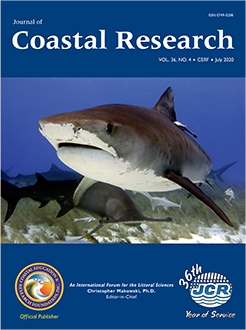de Souza, C.S.; da Conceição, L.R.; Freitas, T.S.S.; Aboim, I.L.; Schwamborn, R.; Neumann-Leitão, S., and Mafalda, P.d.O., Jr., 2020. Size spectra modeling of mesozooplankton over a tropical continental shelf. Journal of Coastal Research, 36(4), 795–804. Coconut Creek (Florida), ISSN 0749-0208.
Size spectra analysis is a useful way of studying biomass and energy flow in ecosystems across trophic levels. The size spectrum reflects a balance of energy and matter between gains through growth and recruitment and losses though mortality in a size-structured community. Therefore, changes in biomass and normalized biomass size spectrum (NBSS) slope and intercept between time or environment can be used to assess the energy transfer efficiency within ecosystems. Linear models were developed to analyze zooplankton biomass and community size structure for the narrow continental shelf and shelf break off Salvador, Brazil, using samples that were collected during 10 oceanographic cruises, from April 2013 to October 2014, and analyzed with a ZooScan. Three descriptors of zooplankton size spectra were examined: size diversity, NBSS slope, and intercept. Copepods were always dominant in abundance. Size spectra varied considerably along a short coast-to-offshore transect of 17 km. The pattern of spatial change presented a predominance of larger size fractions nearshore (flat NBSS slope, –0.56) and the predominance of smaller sized organisms in oceanic waters (steep NBSS slope, –0.88). This gradient was mostly due to the higher abundance of large (>5 mm equivalent spherical diameter) gelatinous organisms (mainly hydromedusae) nearshore. The results suggest that the tropical zooplankton community at the continental shelf off Salvador was characterized by low productivity and low trophic efficiency, especially offshore. Although copepods were dominant in numbers, large-sized gelatinous predators were the key structuring zooplankton taxon in this area.





